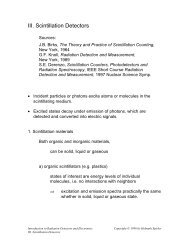VIII.2. A Semiconductor Device Primer
VIII.2. A Semiconductor Device Primer
VIII.2. A Semiconductor Device Primer
You also want an ePaper? Increase the reach of your titles
YUMPU automatically turns print PDFs into web optimized ePapers that Google loves.
The number of occupied electron states Ne is determined by<br />
summing over all available states multiplied by the occupation<br />
probability for each individual state<br />
∑<br />
N = m f ( E )<br />
Since the density of states near the band edge tends to be quite high,<br />
this can be written as an integral<br />
where g(E) is the density of states.<br />
e<br />
∞<br />
∫<br />
E<br />
i<br />
N = f ( E)<br />
g(<br />
E)<br />
dE<br />
e<br />
c<br />
Solution of this integral requires knowledge of the density of states.<br />
Fortuitously, to a good approximation the density of states near the<br />
band edge has a parabolic distribution<br />
( ) ( c ) E E dE E g − ∝<br />
As the energy increases beyond the band edge, the distribution will<br />
deviate from the simple parabolic form, but since the probability<br />
function decreases very rapidly, the integral will hardly be affected.<br />
The second obstacle to a simple analytical solution of the integral is<br />
the intractability of integrating over the Fermi distribution.<br />
i<br />
Introduction to Radiation Detectors and Electronics Copyright © 1998 by Helmuth Spieler<br />
<strong>VIII.2.</strong>a. A <strong>Semiconductor</strong> <strong>Device</strong> <strong>Primer</strong>, Doping and Diodes<br />
i<br />
1/<br />
2





